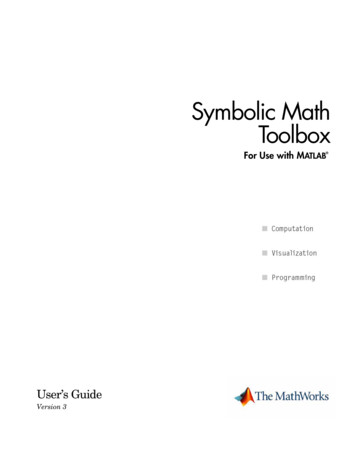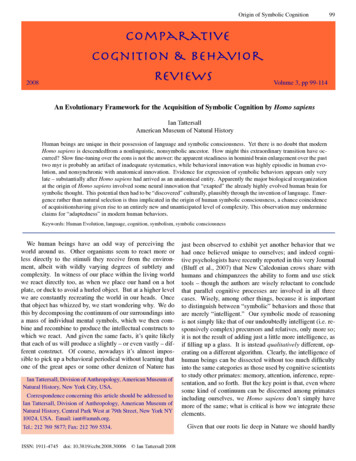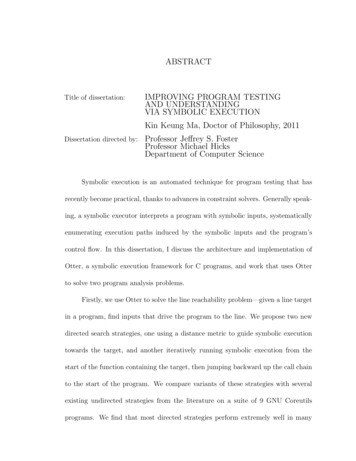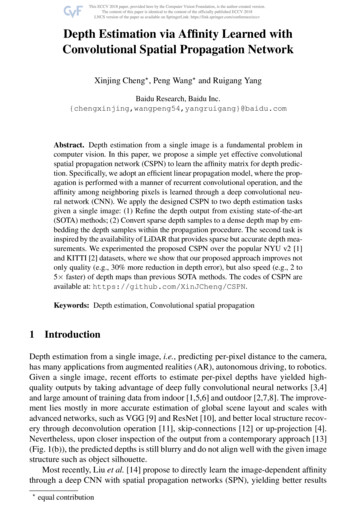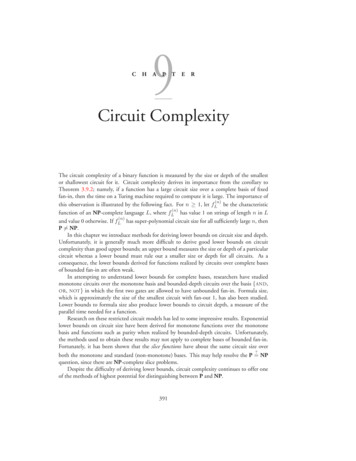
Transcription
An In-Depth Symbolic Security Analysis of the ACME StandardKARTHIKEYAN BHARGAVAN, INRIA, FranceABHISHEK BICHHAWAT, IIT Gandhinagar, IndiaQUOC HUY DO , University of Stuttgart, GermanyPEDRAM HOSSEYNI, University of Stuttgart, GermanyRALF KÜSTERS, University of Stuttgart, GermanyGUIDO SCHMITZ† , University of Stuttgart, GermanyTIM WÜRTELE, University of Stuttgart, GermanyThe ACME certificate issuance and management protocol, standardized as IETF RFC 8555, is an essential element of theweb public key infrastructure (PKI). It has been used by Let’s Encrypt and other certification authorities to issue over abillion certificates, and a majority of HTTPS connections are now secured with certificates issued through ACME. Despite itsimportance, however, the security of ACME has not been studied at the same level of depth as other protocol standards likeTLS 1.3 or OAuth. Prior formal analyses of ACME only considered the cryptographic core of early draft versions of ACME,ignoring many security-critical low-level details that play a major role in the 100 page RFC, such as recursive data structures,long-running sessions with asynchronous sub-protocols, and the issuance for certificates that cover multiple domains.We present the first in-depth formal security analysis of the ACME standard. Our model of ACME is executable andcomprehensive, with a level of detail that lets our ACME client interoperate with other ACME servers. We prove the securityof this model using a recent symbolic protocol analysis framework called DY , which in turn is based on the F programminglanguage. Our analysis accounts for all prior attacks on ACME in the literature, including both cryptographic attacks and lowlevel attacks on stateful protocol execution. To analyze ACME, we extend DY with authenticated channels, key substitutionattacks, and a concrete execution framework, which are of independent interest. Our security analysis of ACME totaling over16,000 lines of code is one of the largest proof developments for a cryptographic protocol standard in the literature, and itserves to provide formal security assurances for a crucial component of web security.CCS Concepts: Security and privacy Formal security models; Security protocols; Web protocol security; Digitalsignatures; Formal security models; Logic and verification; Security protocols; Web protocol security; Networks Protocol testing and verification; Protocol testing and verification; Formal specifications; Theory of computation Cryptographic protocols; Cryptographic protocols.Additional Key Words and Phrases: formal protocol analysis and verification; public-key-infrastructure; certificate issuanceACM Reference Format:Karthikeyan Bhargavan, Abhishek Bichhawat, Quoc Huy Do, Pedram Hosseyni, Ralf Küsters, Guido Schmitz, and Tim Würtele.2021. An In-Depth Symbolic Security Analysis of the ACME Standard. In Proceedings of the 2021 ACM SIGSAC Conference onComputer and Communications Security (CCS ’21), November 15–19, 2021, Virtual Event, Republic of Korea. ACM, New York, NY,USA, 32 pages. https://doi.org/10.1145/3460120.3484588 Also† Alsowith GLIWA GmbH.with Royal Holloway University of London.CCS ’21, November 15–19, 2021, Virtual Event, Republic of Korea. 2021 Copyright held by the owner/author(s). Publication rights licensed to ACM.This is the author’s version of the work. It is posted here for your personal use. Not for redistribution. The definitive Version of Record waspublished in Proceedings of the 2021 ACM SIGSAC Conference on Computer and Communications Security (CCS ’21), November 15–19, 2021,Virtual Event, Republic of Korea, https://doi.org/10.1145/3460120.3484588.1
1INTRODUCTIONThe management of certificates for web servers used to be a very tedious and manual task. To relieve administratorsfrom this burden, the Internet Security Research Group (ISRG) developed the Automatic Certificate ManagementEnvironment (ACME), which provides a protocol to automate the process of domain ownership verification andcertificate issuance. ACME was standardized by the Internet Engineering Task Force (IETF) as RFC 8555 [5] and isnow supported by a wide range of certification authorities (CAs) (e.g., [21, 25, 33, 43, 57]) and many different webserver tools (see [41] for a detailed list). In particular, Let’s Encrypt [43], launched by the ISRG in 2015, was thefirst CA to implement ACME and has provided its service to all users for free (see also their CCS paper on thehistory of ACME [1]). By now, Let’s Encrypt and ACME have become extremely popular and are widely used andtrusted, with more than 1 billion certificates issued so far by Let’s Encrypt alone [40], accounting for about 57% ofcertificates in active use on the web [1].Since ACME is so widely used, a design flaw in ACME can have disastrous consequences. For example, a criticalcryptographic flaw in an early draft of ACME [2] allowed an adversary to obtain certificates for domains notowned by the adversary (see Section 5 for details). This flaw was fixed in the published standard, but to ensureno such protocol flaws remain, it is important to formally verify the security of the ACME standard.Formally Analyzing ACME. Two prior works analyzed early drafts of the ACME protocol using the symbolicprotocol analyzers ProVerif and Tamarin [15, 36]. These analyses were able to automatically identify protocolweaknesses in early ACME drafts and verify their fixes. However, they only considered the core cryptographicmechanisms in the basic certificate issuance message flow for a single domain, resulting in high-level models of afew hundred lines that leave out many of the details of the 100-page ACME standard.ACME relies on recursive control flows, unbounded data structures, and careful state management for longrunning sessions that involve multiple asynchronous sub-protocols. For example, an ACME client can ask theACME server for a certificate that covers a list of domains. The server has to iteratively go through this list andfor each domain therein create a URL, which is an individual endpoint the client later has to connect to. For eachsuch URL, client and server then asynchronously run a subprotocol consisting of several further message roundsin order to verify that the client owns the domain. In particular, the runs of these different subprotocols caninterleave arbitrarily. When the ownership of all domains has been validated, the client can finally ask the serverto issue a new certificate for the domain list and a given public key.This complex set of interactions raises many open security questions that remained unanswered by priorformal analyses. For example, can an attacker participate in a series of asynchronous sub-protocols with anACME server and drive the server into a state where it would be willing to issue the attacker a certificate coveringa domain that it does not own? Such questions have practical, real-world consequences. Recently, a severe flawin the ACME server implementation Boulder (used, e.g., by Let’s Encrypt) was discovered. This flaw was rooted inthe incorrect processing of domain lists and allowed an attacker to obtain certificates for domains it does notown. As a consequence of this flaw, Let’s Encrypt had to revoke more than 3 million certificates [35].The goal of this work is to carry out an in-depth security analysis of the ACME standard that accounts forall these low-level protocol details, so that we can formally prove that an ACME implementation that faithfullyfollows the standard has strong security guarantees.A Detailed Executable ACME Model in F . Writing a detailed formal model for a large protocol standard likeACME is a challenging task. The protocol uses flexible message formats like JSON, unbounded data structureslike domain lists, recursive control flows, and mutable session states, all of which are challenging (and sometimesimpossible) to handle for automated symbolic provers like ProVerif and Tamarin. Furthermore, as the modelgrows to encompass the entire standard, it can be difficult to check that the model itself is correct. For example,the model of TLS 1.3 in Tamarin [22] was over 2,000 lines, even though it did not cover some key protocol features2
like message formats and ciphersuite negotiation. For a model of this size, it is important to be able to executeand test it for specification errors, and to ensure that all the corner cases of the protocol are correctly exercised.Hence, we write a detailed model of the ACME protocol in the F programming language [53] which takescare of all the mentioned details. The full model is over 5,500 lines of F and can be tested to generate symbolictraces for debugging. Given the level of detail in our model, it can be seen as a reference implementation of theACME standard. Indeed, we show how our verified ACME client can be concretely executed to interoperate withreal-world ACME servers, including those run by Let’s Encrypt.Symbolic Security Proofs for ACME in DY . To formally prove security properties for our ACME model,we rely on a recent verification framework called DY [11], a new approach for the symbolic security analysisof protocol code written in the F programming language [53]. DY is the latest in a line of works that usesdependent types to verify cryptographic protocols [3, 6, 8, 16–18, 32, 53]. The key difference with these priorworks is that DY explicitly encodes the global run-time semantics of distributed protocol executions in termsof a global trace, and the symbolic security analysis is proved sound with respect to this semantics within theverification framework itself. Using the global trace, it becomes possible to explicitly model protocol state, randomnumber generation, and fine-grained compromise in a sound way without relying on external pen-and-paperproofs. This, in turn, allows for the verification of sophisticated security properties like forward secrecy andpost-compromise security for cryptographic protocols like Signal [11].Unlike automated symbolic provers like ProVerif or Tamarin that analyze abstract protocol models, the aimof DY is to help programmers write and formally verify executable code that accounts for both the high-leveldesign and the low-level implementation details of a cryptographic protocol and the application code that uses it.In particular, DY supports the verification of recursive and stateful protocols with unbounded data structureslike lists and trees, which are typically hard to reason about with automated provers that lack general induction.Conversely, unlike automated provers, proofs in DY require manual annotation. For example, our 5,500 lineACME model requires a further 5,200 lines of proof, whereas the Tamarin and ProVerif analyses for 100-300line models of small subsets of ACME are mostly automatic. However, the level of proof effort in our work iscommensurate with other in-depth protocol analyses. For example, the mentioned 2,000 line TLS 1.3 model inTamarin [22] required about 1,000 lines of lemmas, even for a high-level protocol model.Importantly, the type-based methodology of DY is modular and scales better than the whole-protocol analysisof automated provers. The verification of large protocols like TLS 1.3 in Tamarin and ProVerif can take tens ofhours or even days of verification time, whereas in DY , each module can be implemented and verified separately.For ACME we have 37 modules with an average verification time of about 1.5 minutes per module, totaling about60 (single-core) minutes on a standard desktop.DY ’s approach to enable such modularity is based on a combination of local and global reasoning: predicateson the global trace capture the inter-dependencies between different states and different components of theprotocol while local invariants ensure that every component preserves these predicates. In our analysis, we stateand mechanically verify the local invariants for each component, and then we prove that these local invariants,when combined with predicates on the global trace, yield the desired protocol security goals. Hence, our proofincludes the composition of the protocol with every component, and if there were a composition flaw, the overallproof would fail.Extensions to DY . In principle, DY is a suitable framework for the in-depth analysis of a large protocolstandard like ACME. However, being a very recent analysis framework, DY still has to demonstrate what it isreally capable of. So far, DY has not been used for such a large analysis, and we still needed to extend the DY approach in three ways to model and verify ACME.First, DY assumes a standard symbolic equational theory for signatures, but as illustrated by an attack on anearly draft of ACME presented in [2], many signature schemes are vulnerable to so-called key substitution attacks3
in which the adversary crafts a new verification key for a new message and the given signature. We thereforeextend the model of signatures in DY to account for such attacks (see Section 3.2) and use the resulting weakerassumptions on signatures when verifying our model of ACME.Second, the domain authentication sub-protocol in ACME relies on a trusted channel between the domainowner and the ACME server. For example, the domain owner is expected to write a file to a web server thatonly she has access to, and we assume that the ACME server can securely read this file. A natural way to modelsuch communication is via an authenticated channel, which is not currently supported by DY . We extend thecommunication model of DY to include an authenticated channel for each principal that only the principal canwrite to but anyone can read. This extension is completely generic, and hence, of independent interest.Third, DY has not been used to create interoperable implementations so far. We propose a novel approach totransform a DY model into a concrete implementation that can successfully run protocol roles with real-worldcounterparts, and we use this methodology to test interoperability between our ACME client and other ACMEservers.Contributions. We present the first comprehensive formal model of the ACME standard (Section 6). Our 5,500line model of ACME is written in the F programming language and is executable. We illustrate its level of detailby demonstrating that our client code is, in fact, interoperable with real-world ACME servers, including Let’sEncrypt (Section 8). We present symbolic security theorems of this model using the DY framework: in particular,we prove that certificates are only issued to the rightful owner of the domains included in the certificate andthat the overall protocol flow provides integrity guarantees to clients and servers (Section 7). Our proofs rely onnovel extensions to the DY framework that are of independent interest (Section 3). Our full proof developmenttotals more than 16,000 lines of F code and is one of the largest and most in-depth analyses of a cryptographicprotocol standard in the literature.2DY : SYMBOLIC SECURITY ANALYSIS IN F We here give a brief overview of DY sufficient to follow the rest of the paper and refer the reader to [11]for details, to [13] for a tutorial-style introduction, and to [49] for more information on the umbrella projectREPROSEC.A Global Trace of Execution. DY models the global interleaved execution of a set of protocol participants (orprincipals) as a trace of observable protocol actions (or entries). As a principal executes a role in some run of aprotocol, it can send and receive messages, generate random values, log security events, and store and retrieve itssession state, and each of these operations either reads from or extends the global trace.In F syntax, the global trace is encoded as an array of entries:type entry RandGen: p:principal b:bytes l:label u:usage entry SetState: p:principal v:array nat s:array bytes entry Message: s:principal r:principal m:bytes entry Event: p:principal ev:string ps:list bytes entry Compromise: p:principal sid:nat version:nat entrytype trace array entryEach trace index can be seen as a timestamp for the corresponding entry. An entry RandGen p b l u at indexi indicates that a principal p generated a random value b at i with a secrecy label l and intended usage u (wediscuss labels and usages later). The entry SetState p v s indicates that principal p stored an array of values scontaining the current states of its active sessions (numbered 0.length(s) 1), where the current version numberof each session is recorded in v. The entry Message s r m says that a message m was sent on the network4
(ostensibly) by principal s for principal r. The entry Event p ev ps indicates that a principal p logged a securityevent ev with parameters ps. The dynamic compromise event Compromise p sid version says that the attackerhas compromised a specific version of a session sid stored by principal p (and hence can obtain the correspondingsession state).Protocol Code in the DY Effect. The protocol code for each principal cannot directly read or write to the trace,but instead must use a typed trace API that enforces an append-only discipline on the global trace using a customcomputational effect called DY. For example, the API provides a function gen for generating new random valueswith the following type:val gen: p:principal l:label u:usage DY bytes(requires (𝜆 t0 ))(ensures (𝜆 t0 r t1 match r with Error t0 t1 Success v len t1 len t0 1 entry at (len t0) (RandGen p v l u)))The pre-condition of the function (denoted by requires) is , indicating that it is satisfied in all input traces t0.The post-condition is stated in terms of the input trace t0, output trace t1 and the return value r. It says that ifthe function gen successfully returns (without an Error) then the trace has been extended by the correspondingRandGen entry; otherwise, the trace is unchanged.Functions annotated with the DY effect are total (i.e., they always terminate) but they can return errors. Theycan call pure (side-effect free) functions like crypto primitives, or read entries from the trace, or add new entries atthe end of the trace, but cannot do any other stateful operations. The DY trace API offers a set of base functionsin the DY effect that higher model layers (see below) build upon. In addition to gen above, it provides functions tosend and receive messages, store and retrieve states, and log security events. Using these functions, and a libraryof functions for cryptography and bytes manipulations, we can build stateful implementations of protocols likeACME, as we will see in later sections.A Symbolic Cryptographic API. DY provides a library for the manipulation of bytes. The interface of thislibrary treats bytes as abstract using the type bytes and provides functions for creating constant bytes, concatenating and splitting bytes, and calling various cryptographic functions on bytes such as public-key encryption andsignatures, symmetric encryption and message authentication codes, hashing, Diffie-Hellman, and key derivation.For example, the API for public-key signatures is as follows:val vk: sk:bytes bytesval sign: sk:bytes msg:bytes bytesval verify: pk:bytes msg:bytes sg:bytes boolThe function vk computes the public verification key corresponding to a private signature key; sign creates asignature given a signing key and a message; verify checks a signature over a message using the verification key.The library interface also provides a series of functional lemmas relating to these functions, stating, for example,that decryption is an inverse of encryption, or that splitting concatenated bytes returns its components, or (asdepicted below) that signature verification always succeeds on a validly generated signature.val verify sign lemma: sk:bytes msg:bytes Lemma (verify (vk sk) msg (sign sk msg) true)This cryptographic API is generic and can be implemented in many ways, including by calling concrete cryptographic libraries. DY provides a symbolic implementation of bytes as an algebraic data type. Each functionis either implemented as a constructor or a destructor of this type. For example, the function call sign sk msgis implemented using a constructor Sign sk msg of the bytes type, whereas verify is implemented by pattern5
matching over the input signature to inspect whether it has the form Sign sk msg for the corresponding signingkey. This kind of symbolic encoding of cryptography is originally due to Needham and Schroeder [47], and formsthe basis for all symbolic protocol analyses, including ProVerif [20], Tamarin [45], and prior refinement typesystems [16].Note, however, that this symbolic model is hidden behind the abstract cryptographic API, and hence is invisibleto any protocol (or attacker) code that uses this library. Such code can only manipulate bytes by using thefunctions in the interface; it cannot, for example, extract the signing key from a signature or invert a hashfunction.The Dolev-Yao Attacker. The symbolic Dolev-Yao active network attacker [26] is modeled as an F programthat is given full access to the cryptographic API and limited access to the global trace API. It can call functionsto generate its own random values (by calling gen), send a message from any principal to any principal, andread any message from the trace. Notably, it cannot read random values or events from the trace, and a priori itcannot read the session states stored by any principal. However, the attacker is given a special function that itcan call at any time to add an entry Compromise p sid version to the trace. Thereafter, the attacker can retrievethe compromised version of the state from the trace.Of course, the attacker can also call any function in the cryptographic API using bytes it has already learnedto compute new messages that it can then insert into the trace, causing honest principals can receive them.Furthermore, each protocol model may provide the attacker with an additional API that it may use to initiate andcontrol protocol sessions at both honest and compromised principals. The predicate attacker knows at index bsays that the attacker can derive bytes b at a given index in the global trace, and hence it characterizes theattacker’s knowledge.Symbolic Debugging. Code written in DY can be executed symbolically to obtain traces that can be printedand inspected for debugging. This kind of execution is invaluable to test the model and ensure that it behavesas expected. In particular, we can ensure that there isn’t a bug in the protocol code that prevents protocol runsfrom finishing. Furthermore, we can write example attacker code and test potential attacks against our protocolimplementation. Of course, the goal of verification is to ensure that no such attacker program can violate theintended security goals of the protocol.Security Goals as Trace Properties. The security goals of each protocol are stated in terms of reachable globaltraces. To prove that some instance of bytes b is kept secret by a protocol, we ask if it is possible for the attackerto use some combination of calls to the crypto API, trace API, and the protocol API such that in the final trace t,the attacker knows b. Protocol authentication properties are stated in terms of correspondences between eventslogged at different principals. For example, we may ask that in all reachable traces, if a principal p ends a sessionwith some peer principal p' by logging the event Event p "end"[p',x,.] at index i, then at some index j i, theprincipal p' must have logged an event Event p' "begin"[p,x,.] with matching parameters. This way of encodingauthentication properties as correspondences between events is similar to other symbolic analysis methods andis originally due to Woo and Lam [55].The main proof methodology for proving security goals stated as trace properties is to establish an invariantover all reachable traces and prove that this invariant implies the desired goals. In particular, we need to provethat all functions that can modify the trace, either on behalf of honest protocol code or the attacker, preserve theinvariant. Stating a complete global invariant that captures all protocol runs is challenging and time-consumingsince a large part of the invariant typically involves generic assumptions about the well-formedness of bytes andthe secrecy of keys. Hence, DY offers a modular proof methodology, where programmers only need to defineand prove local protocol-specific session invariants and security goals, and the framework fills in generic securityinvariants that are proved once-and-for-all for all protocols.6
DY defines a second layer of labeled APIs for cryptography and stateful code as well as a second computationaleffect DYL on top of the DY effect that enforces a global trace invariant called valid trace. Functions in the traceAPI and with the DYL effect take valid trace as both pre- and post-condition. The invariant consists of severalcomponents, some generic and some that have to be defined for each protocol. We describe these componentsbelow.Secrecy Labels and Usage Predicates. The labeling predicate has label i b l says that a bytes b has a secrecylabel l at trace index i. Each bytes is assigned a unique label that indicates who can read it. For example, alabel CanRead [P p1; P p2] indicates a secret that only the principals p1 and p2 are allowed to read, whereas thelabel Public indicates that anyone can read it. Secrecy labels form a lattice, where can flow i l1 l2 says that thelabel l1 is equal or less strict than the label l2 at trace index i. In particular, Public flows to all other labels, andCanRead [P p] can flow to Public at index i if Compromised p sid v occurs in the trace at or before i.The labeled APIs enforce a labeling discipline that ensures that secret values never flow to public channelswhere the attacker can read them. In particular, the valid trace invariant states that all network messages musthave the label Public, and all states stored at a principal p must flow to CanRead [P p]. If a secret value has to besent over the network, it must first be encrypted with a key whose label is at least as strict as the message’s label.We refer the reader to [12] for the full set of labeling rules.In addition to secrecy labels, the labeled APIs also enforce usage pre-conditions. Each key is assigned anintended usage, so for example, a signature key cannot be used as an encryption key. Furthermore, each keyis assigned a usage predicate controlling what kinds of messages it may be used to encrypt or sign. Of course,these restrictions only apply to honest principals. For example, the labeled API for the signature and verificationfunctions is as follows:val vk: i:nat p:principal sign key i (CanRead [P p]) verify key i (CanRead [P p])val sign pred: i:nat p:principal msg:bytes predval sign: i:nat p:principal sign key i (CanRead [P p]) m:msg i Public{sign pred i p m} msg i Publicval verify: i:nat p:principal verify key i (CanRead [P p]) m:msg i Public sig:msg i Public b:bool{b (compromised i p sign pred i p m)}In this API, signature keys are now labeled with a secrecy label CanRead [P p] corresponding to some principalp. The corresponding verification keys are Public, and we additionally annotate them with the label of thecorresponding signature key. The predicate sign pred is a usage predicate that each protocol defines to indicatewhat kinds of messages may be signed in the course of the protocol. This predicate is then used as a pre-conditionfor sign, ensuring that protocol code does not accidentally call sign with a message that does not conform tosign pred. Conversely, if verify succeeds then the API guarantees that the signature must be valid, and hence thesigned message must satisfy sign pred, unless the signature key was compromised by the attacker.Protocol State Invariants and Security Goals. Using secrecy labels and usage predicates, the labeled APIsensure that the only messages that may be sent out on the network obey the labeling discipline. In addition,each protocol defines a state invariant state inv p v s that must hold for each state that a principal tries to storeby adding an entry SetState p v s into the global trace. This invariant typically records the secrecy labels of allthe values stored in the state as well as any integrity properties known about these values at the current stageof the protocol. In particular, the invariant requires that the labels of all session states stored at p must flow toCanRead [P p], that is, they must be readable by p.To state the secrecy goals of a protocol, it is enough to annotate a desired protocol value with a secrecy labeland typecheck the protocol code against the labeled APIs. For well-labeled programs, DY provides a secrecy7
lemma that states that bytes with a label (say) CanRead [P p1; P p2] cannot be learned by the adversary unless p1or p2 are compromised. To state authentication goals as event correspondences, we define an event pre-conditionevent pred p ev ps that states when a principal p can issue Event p ev ps. For example, we can ask that an eventend [x] can only occur in a trace where begin [x] has already occurred before. By typechecking, we ensure thatthis predicate holds at each logged event, and hence that the protocol authentication goal is preserved.3EXTENSIONS OF DY We here describe our generic extensions to DY . We will later use these extensions for our analysis of ACME, butall of these extensions are of independent interest.3.1Authenticated ChannelsSo far, DY supports public messages only without any integrity guarantees, i.e., the overall communicationmodel assumes an adversary who controls the network. Some protocols, such as ACME, assume as a setupassumption that principals can exchange certain messages in an authenticated way. If a party receives such anauthenticated me
An In-Depth Symbolic Security Analysis of the ACME Standard KARTHIKEYAN BHARGAVAN, INRIA, France ABHISHEK BICHHAWAT, IIT Gandhinagar, India QUOC HUY DO , University of Stuttgart, Germany PEDRAM HOSSEYNI, University of Stuttgart, Germany RALF KÜSTERS, University of Stuttgart, Germany GUIDO SCHMITZ†, University of Stuttgart, Germany TIM WÜRTELE, University of Stuttgart, Germany

